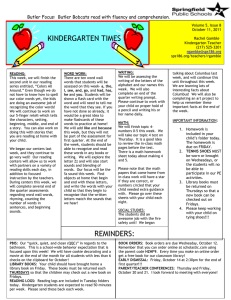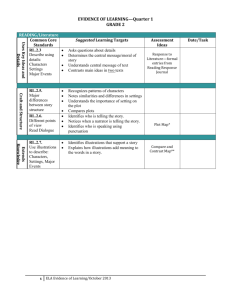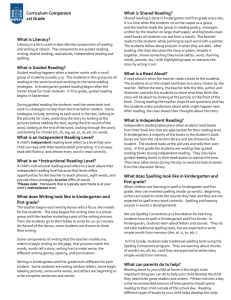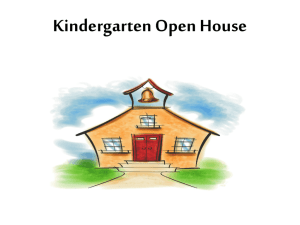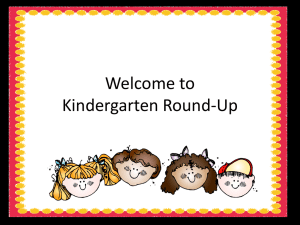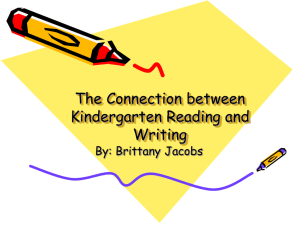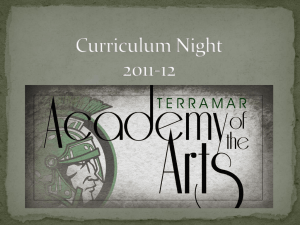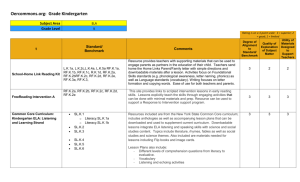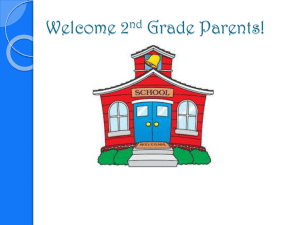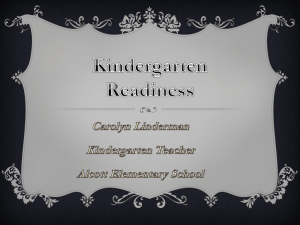here.
advertisement
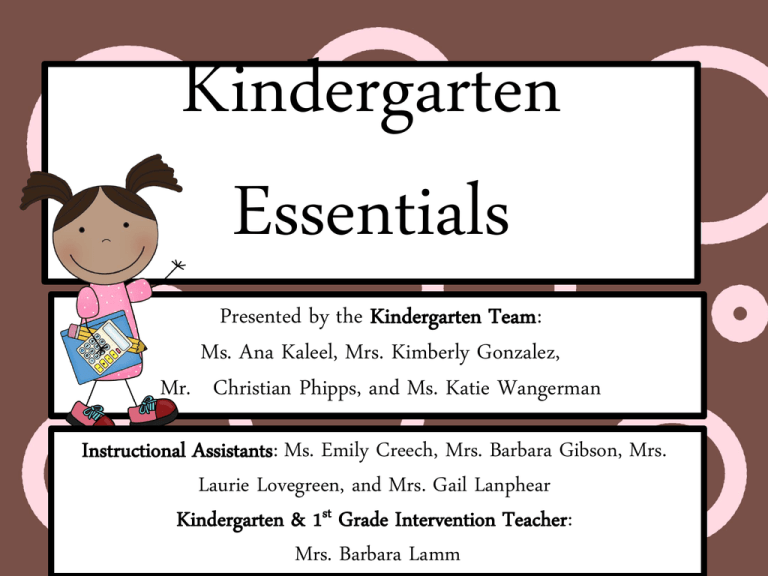
Kindergarten Essentials Presented by the Kindergarten Team: Ms. Ana Kaleel, Mrs. Kimberly Gonzalez, Mr. Christian Phipps, and Ms. Katie Wangerman Instructional Assistants: Ms. Emily Creech, Mrs. Barbara Gibson, Mrs. Laurie Lovegreen, and Mrs. Gail Lanphear Kindergarten & 1st Grade Intervention Teacher: Mrs. Barbara Lamm Agenda Important Reminders 5 Minutes Literacy Curriculum 8 Minutes Math Curriculum 8 Minutes Science & Social Studies Curriculum 4 Minutes Brief Q & A 5 Minutes Important Reminders Practice these things every day with your child: •Shoe tying •Student ID number •Letters and sounds •Writing first and last name •Stating parents’ names •Clothing: buttons, ties, zippers, etc. •Opening lunch containers independently •Phone number and address Parent Reminders •Read and sign red folder daily •Water only at snack •Please pack snack in a disposable container •Transportation changes must be made in writing •For last-minute changes, call the office •E-mail is great, but not for urgent information •Homework and reading 20 minutes every night begins 2nd Quarter •Attendance is crucial for Kindergarten success Standards-Based Grading •Reports cards are issued quarterly •This is a change from past years •Grades are 1, 2, 3, and 4 •3* has been omitted “I made this” Meets or exceeds expectations independently 4 “I made this” Meets expectations 3 “We made this” Meets expectations with teacher support 2 “We’re working on it” Not there yet still working 1 ELA Curriculum: Reading Kindergarten students, over the course of the school year, will learn foundational reading skills such as: •Strategies for reading •Phonemic Awareness •Using illustrations to inform reading •Knowledge of high frequency words •Common opposites (antonyms) •Phoneme Segmentation As foundational reading skills develop, students will begin to explore informational text (nonfiction). Students will work on listening and speaking skills appropriate to academic environments in the kindergarten classroom as well as environments outside of the classroom. Strategies for Reading •Use picture clues •Find sight words first •Go back and re-read to see if it makes sense •Environmental print •Say first sound •“Roller Coaster” for consonant-vowel-consonant •Find part of the word you know (chunk) What is phonemic awareness? The concept that each letter (phoneme) is responsible for making a sound. In Phonemic awareness includes: •Identifying beginning, middle, and end sounds •Separating a word into its sounds •“sounding out” or “stretching” words High Frequency Words High frequency words, or “sight words” are words that children learn by rote memory. These are foundational for beginning readers and writers. Sight words include common and/or irregular words, such as I, like, is, said, the, and more. ELA Curriculum: Writing Beginning of the Year • Modeling writing-where to start writing (left to right), beginning sentence with capital letter, ending with a period • Sentences using sight words • Informational/explanatory texts • Drawing, dictating, writing informative/explanatory text that tell what they are writing about and give some information about the topic (this continues throughout the year) • Question words: who, what, where, when, why, how? • Spell simple words phonetically • Tell about a single event and list the events in order and provide a reaction to what happened (Example: I went to the beach with my family and I saw dolphins. It made me happy because dolphins are my favorite animal) •Write a simple sentence •With guidance from teacher/adults, respond to questions and suggestions from peers and add details to strengthen writing ELA Curriculum: Writing Middle of the Year •Opinion writing: Using a combination of drawing, dictating, and writing to compose opinion pieces in which they tell a reader the topic or the name of the book they are writing about and state an opinion or preference about the topic or book (example: I like the _____ book best because ______.; Or: I like the beach better than the mountains because ______.) •Procedural writing: How-to Books ELA Curriculum: Writing End of the Year •Use frequently occurring nouns and verbs •Distinguish meanings of verbs describing same general action (sleeping, napping, dozing, etc.) •Informational Writing- All About… Books •Persuasive writing •Participate in shared research and completing writing projects (explore several books from the same author and express opinions about them) •Demonstrate conventions (standard English capitalization, punctuation, and spelling) when writing Invented Spelling Invented spelling is a very important step in learning to write. Please encourage invented spelling! Please do not correct spelling, except for sight words. Children begin to write with strings of letters… Djgosmjvuiwpornci (I like to run with my friends.) Then they may indicate the first sound or two of each word… ILTRNWMFR. (I like to run with my friends.) They may begin to include more sounds… I like to rn wt my frds. . I like to run with my friends.) ( And eventually use conventional spelling. I like to run with my friends. Math Curriculum Key Math Objectives: •Write numbers 1-20 •Rote count 1-100 by ones and tens •Count using one-to-one correspondence (written and verbal) •Compose and decompose numbers within ten •Add and subtract within ten using multiple strategies •Fluently add and subtract within five (math facts) •Identify and draw 2D shapes •Identify 3D shapes •Compare numbers (greater, equal, less) •Understand numbers are composed of tens and ones •Describe the measurable attributes of a given object 2D and 3D Shapes circle rectangle square pentagon rhombus hexagon triangle trapezoid cube cone pyramid sphere Composing and Decomposing Numbers Show different ways to make a number. Example: different ways to make 10. 2+8 5+5 7+3 9+1 Science Curriculum Three science units: 1. Investigating Properties 2. Weather 3. Animals Two By Two Investigating Properties Main Objectives: •All physical objects have properties that can be observed, ordered, classified, and compared: •People can distinguish and describe objects and materials by their observable properties. •People can use the properties of objects and materials as criteria to compare and classify the objects and materials. •People can use the properties of objects and materials as criteria to arrange the objets in a serial order. Weather Main objectives: •Understanding the elements of weather helps us plan our daily lives: •Weather is characterized by features such as temperature, wind speed and direction, and precipitation. •Weather may be quantified using tools such as thermometers, rain gauges, and wind speed and direction. •Water exists in solid, liquid, and gaseous (vapor) states. Cloud and fog are made of droplets of water. •Humans can use their observations and data records to understand and forecast the weather. Scientists who do this are called meteorologists. Animals Two by Two Main objectives: •Living things and their habitats have characteristics that can be observed, compared, and categorized. •Animals have unique characteristics that perform specific functions. •Animals demonstrate certain behaviors influenced by internal and external cues. •Animals studied directly include: •Fish •Snails •Earthworms •Isopods •Animal survival depends on the space and conditions that make up their environment including water, food, air, waste removal and a particular temperature range. Social Studies Curriculum Four Social Studies units: •First Quarter: “I am a Citizen.” •Second Quarter: “We Have Needs and Wants.” •Third Quarter: “We Are Alike! We Are Different!” •Fourth Quarter: “What’s Around Me?” Field Trips Marbles Duke Energy Center to see Rudolph NC Science Museum NCSU Farm Questions?

